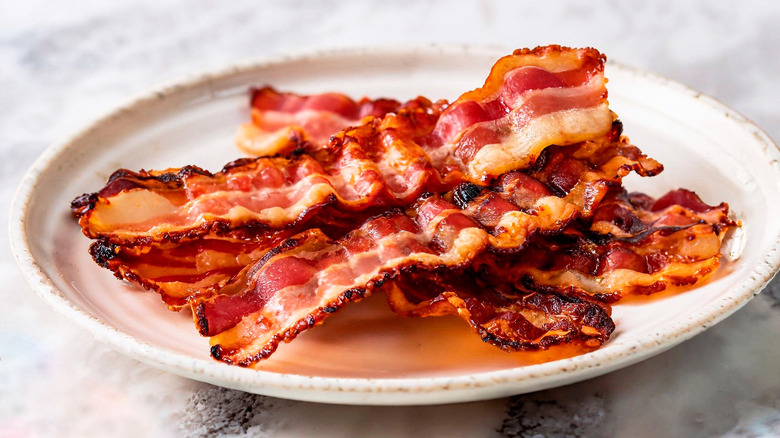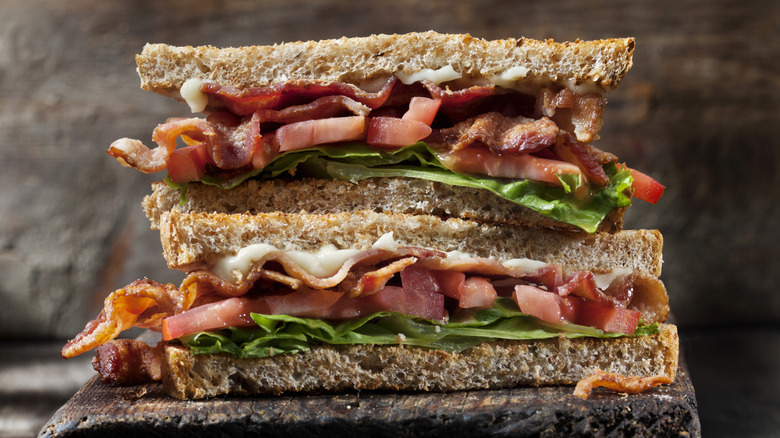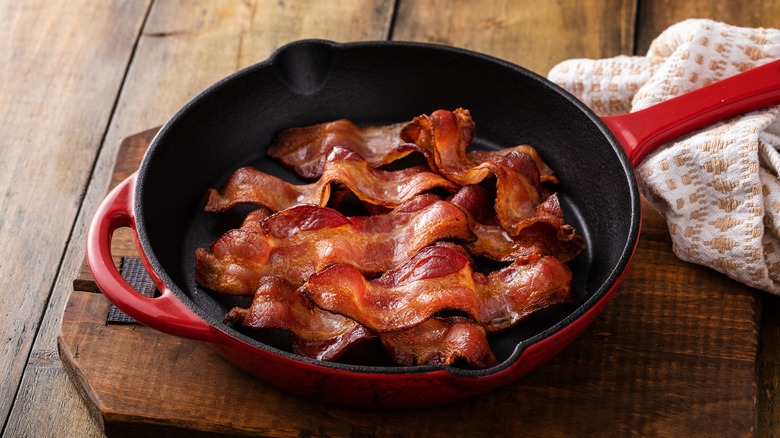Center Vs Thick-Cut Bacon: What's The Difference?
Whether it's gracing a breakfast plate or adorning a cheeseburger, bacon adds a delicious flavor to dishes while creating a crispy texture. However, when you're perusing the bacon section of the grocery store, it can get quite overwhelming. Beyond how the bacon is cured, the most important variation is what type of cut you choose. You can always opt for standard, but both center-cut and thick-cut bacons are great options depending on your needs.
Center-cut bacon is known for having around 30% less fat than standard American bacon. This is because center-cut bacon is actually just the standard variety but with the fatty ends removed, and the end result is a leaner bacon that will become crunchy easily. While the price between standard and center-cut bacon may appear the same at first glance, the latter's package size is typically smaller due to the shorter strips. That means you're paying the same amount for less bacon.
Thick-cut bacon is on the other end of the scale, with plenty of fat marbling and a chewier texture. These slices of bacon typically are cut around ⅛ inch thick, which is twice the width of standard bacon slices. This cut results in a heartier bite that doesn't crisp up very much. Standard bacon typically has around 16 slices per pound, but with thick-cut it averages closer to 10 to 12 slices per pound. This is worth keeping in mind if your recipe calls for a certain number of bacon strips.
How to use center-cut and thick-cut bacon
Each cut of bacon has their ideal time and place when it comes to cooking. No matter which bacon you choose, this cured meat creates a smoky flavor and adds a bit of richness to each dish that includes it. Familiarize yourself with the pros and cons of each cut of bacon and you'll always know which to use.
Center-cut bacon is ideal for recipes where you don't want too much fat, such as bacon-wrapped vegetables or on top of a quiche. Using this leaner cut will avoid you having to blot away excess grease from the finished dish. Since the fatty ends are removed from center-cut, the bacon is more uniform in appearance than some other varieties. This may be preferred when you're making large batches in the oven (and need everything to cook evenly) or if a consistent presentation is required.
Thick-cut bacon is great for dishes where you want a meaty bite, but not an overly crunchy texture. Since the fat marbles throughout each slice of thick-cut bacon, it's hard for the leaner parts of it to crisp up thoroughly in the pan. This makes it perfect for anywhere you want a heartier bite, such as a BLT sandwich, or need some extra bacon fat, like pasta carbonara. However, don't confuse thick-cut bacon with pork belly; the two may come from similar parts of the pig but are not interchangeable ingredients.
Tips for cooking better bacon
Whether you choose standard, center-cut, or thick-cut bacon, there are a few ways you could be messing up when preparing it. These are mistakes almost everyone makes when cooking bacon, but by utilizing the handy tips below you'll be making wow-worthy meals in no time.
When cooking bacon, start with a cold pan and not-so-cold bacon. Take the bacon out of the fridge about 15 minutes beforehand so it can come to a more even temperature between the meat and fat (which leads to uniform cooking). Then, place it in an unheated pan before putting it on the stovetop. This allows for the fat to render out and crisp up the bacon evenly, as opposed to using a preheated pan, which locks the fat in and leads to sogginess.
You may need to prepare your bacon in batches. Overcrowding the pan can lead to uneven cooking, with some parts of the meat being overdone while others remain raw. And even if the bacon all cooks to a safe temperature, an overcrowded pan creates more steam, which leads to floppy bacon instead of crunchy. After your meat is all cooked up, don't forget to save the fat for another day. Jar up your bacon grease properly and you'll have a flavorful option on hand to add to everything from morning biscuits to stewed vegetables.



